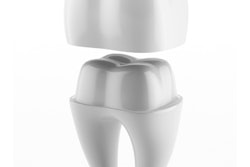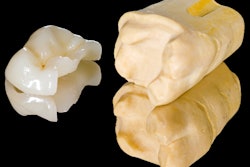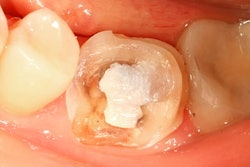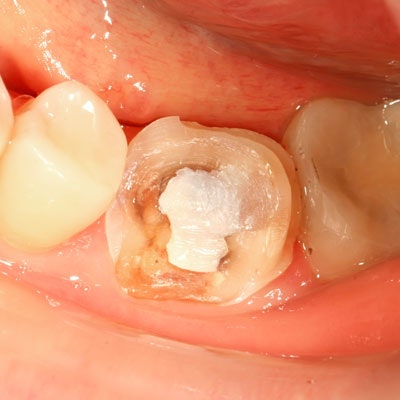
A new study investigating the fracture resistance of restorative materials found that the strength of zirconia ceramic restorations rivaled that of intact teeth. Zirconia ceramic also outperformed glass ceramic and resin composite restorations.
The researchers investigated how well the three materials resisted fractures by simulated chewing forces and the environment of the oral cavity. They published their findings in the Journal of Esthetic and Restorative Dentistry (January 25, 2018).
"The resistance of teeth to fracture is significantly influenced by the preparation design and the restorative material," wrote the authors, led by Ramy Ahmed Wafaie, BDS. Dr. Wafaie is from the department of operative dentistry at the Delta University for Science and Technology Faculty of Oral and Dental Medicine in Gamasa, Egypt.
Comparing materials
While restored teeth are more susceptible to fractures than nonrestored teeth, materials manufacturers are continually inventing new ways to strengthen restorative materials. Therefore, the researchers decided to conduct a lab-based study to determine the fracture resistance of some new and existing composite and ceramic restorative materials.
The researchers included a popular light-curing resin composite, lithium disilicate glass ceramic, and yttrium-stabilized zirconia ceramic in their study. See the table below for the brands and properties of each of the studied materials.
| Materials used in the study | ||
| Material | Brand name | Manufacturer |
| Light-curing resin composite | SR Nexco | Ivoclar Vivadent |
| Lithium disilicate glass ceramic | IPS e.max Press | Ivoclar Vivadent |
| Zirconia ceramic | ICE Zirkon | Zirkonzahn |
For the study, the researchers used 70 sound, extracted maxillary premolars, reserving a group of 10 intact teeth as a control. The remaining teeth were divided into six groups with 10 teeth each:
“The resistance of teeth to fracture is significantly influenced by the preparation design and the restorative material.”
- Inlay cavity restored with SR Nexco
- Onlay cavity restored with SR Nexco
- Inlay cavity restored with IPS e.max Press
- Onlay cavity restored with IPS e.max Press
- Inlay cavity restored with ICE Zirkon
- Onlay cavity restored with ICE Zirkon
To test fracture resistance, the researchers thermocycled all 70 teeth for 5,000 cycles using distilled water at a temperature similar to that of the oral cavity. They also subjected the teeth to 500,000 cycles of cyclic loading to simulate chewing forces.
Teeth with ICE Zirkon restorations showed similar fracture rates to intact teeth. The difference in fracture rates between the inlay and onlay ICE Zirkon restorations also was not significant.
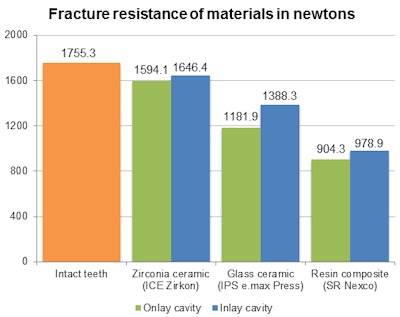
"This is consistent with the mechanical structure of yttrium-stabilized zirconia, which is a glass-free, high-strength polycrystalline ceramic material," wrote the researchers, who also noted that similar studies have found comparable results for the material.
The IPS e.max Press glass ceramic restorations showed the next lowest failure rate, followed by the SR Nexco resin composite. However, teeth with SR Nexco and IPS e.max Press restorations both fractured significantly more often than intact teeth and teeth with ICE Zirkon restorations.
The researchers attributed the higher fracture rate of IPS e.max Press restorations to the material's relatively low resilience, which reduces the ability of restorations to absorb shocks. Meanwhile, the SR Nexco composite restorations fractured more often because the material is not as elastic as zirconia, they noted.
Only a lab study
It is important to note that the current study only compared three restorative materials and that the materials were tested in a laboratory environment. Nevertheless, it suggests that the strength of zirconia ceramic restorations is similar to those of intact teeth.
"The current study results showed that teeth restored with zirconia ceramic inlay and onlay restorations have approximately the same fracture resistance values," the study authors wrote. "This could be attributed to the high strength of zirconia material, which may have compensated for the strength loss of the tooth resulting from onlay cavity preparation."




